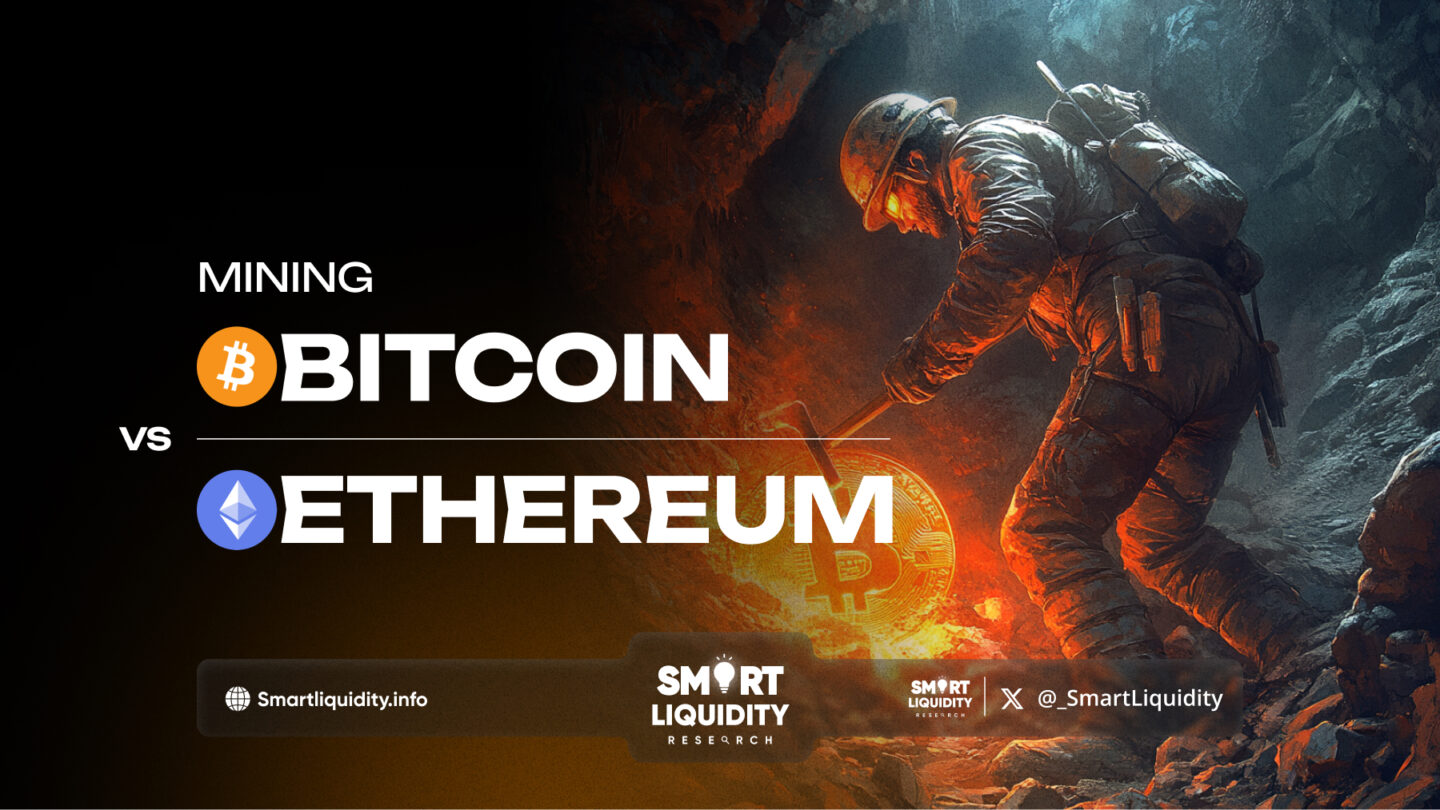Mining Bitcoin vs. Mining Ethereum


Cryptocurrency mining is key to securing networks, validating transactions, and releasing new coins. However, mining Bitcoin and Ethereum involves distinct challenges, technologies, and rewards. This article explores the differences in their mechanisms, hardware needs, energy use, rewards, and future prospects.
Understanding Bitcoin and Ethereum Mining
Both Bitcoin (BTC) and Ethereum (ETH) utilize mining to process transactions and secure their respective networks, but they rely on different consensus mechanisms.
- Bitcoin Mining: Bitcoin uses a Proof of Work (PoW) consensus mechanism to secure its network. In PoW, miners compete to solve complex cryptographic puzzles, and the first miner to solve the puzzle gets to add a new block to the blockchain and receives a block reward in BTC. Bitcoin mining is highly competitive, and as the network grows, the difficulty of these puzzles increases.
- Ethereum Mining: Ethereum also used to rely on PoW but has recently transitioned to Proof of Stake (PoS) with its Ethereum 2.0 upgrade, aiming to improve scalability, energy efficiency, and security. However, for a time, Ethereum miners solved cryptographic puzzles in a similar manner to Bitcoin miners, but with different algorithms. Now, Ethereum miners have become validators under PoS, where they stake ETH to secure the network, and transaction validation is based on the amount of ETH staked.
Mining Hardware Comparison
The hardware required for mining Bitcoin and Ethereum is crucial for both profitability and efficiency.
- Bitcoin Mining Hardware: Bitcoin miners primarily use ASIC (Application-Specific Integrated Circuit) machines, which are custom-built for the sole purpose of mining Bitcoin. These machines are incredibly powerful and highly efficient but are expensive and not adaptable to other cryptocurrencies. Popular models include the Antminer S19 Pro and the Whatsminer M30S. ASIC miners are ideal for Bitcoin mining because they can perform trillions of hash computations per second, providing a competitive edge in the network.
- Ethereum Mining Hardware: Ethereum mining historically relied on GPU (Graphics Processing Unit) rigs, which are more versatile and can be used to mine other cryptocurrencies. GPUs are capable of handling the Ethash algorithm that Ethereum utilizes. Popular brands for GPU mining include NVIDIA and AMD. GPU rigs are still used for other cryptocurrencies, but with Ethereum’s shift to PoS, their role in mining Ethereum has significantly decreased.
| Hardware | Bitcoin Mining | Ethereum Mining |
| Type | ASIC | GPU |
| Efficiency | Very High | Moderate to High |
| Cost | Expensive | Affordable (for individual miners) |
| Flexibility | Limited to Bitcoin | Can mine multiple coins |
| Lifespan | Long (but specific to Bitcoin) | Variable (depending on market) |
| Examples | Antminer S19 Pro, Whatsminer M30S | NVIDIA RTX 3080, AMD RX 580 |
Energy Consumption and Environmental Impact
Energy consumption has become a controversial aspect of cryptocurrency mining, particularly with Bitcoin’s PoW mechanism.
- Bitcoin Energy Consumption: Bitcoin mining requires a massive amount of computational power. The network’s security depends on the collective computational work of miners, leading to enormous electricity consumption. Studies have estimated Bitcoin’s annual energy usage to be comparable to that of some medium-sized countries. The environmental impact is significant, with concerns about carbon emissions, especially if the energy comes from non-renewable sources.
- Ethereum Energy Consumption: Ethereum’s PoW mining is also energy-intensive, though typically, the total energy consumption is lower than Bitcoin due to Ethereum’s different consensus mechanism and hashing algorithm. However, with the transition to Proof of Stake in Ethereum 2.0, energy consumption has dropped dramatically. Validators in PoS do not require extensive computational power, significantly lowering the environmental impact compared to PoW.
| Cryptocurrency | Energy Consumption | Environmental Impact |
| Bitcoin | Very High | High carbon footprint |
| Ethereum | High (PoW) | Moderate (PoW), Low (PoS) |
| Ethereum 2.0 | Low (PoS) | Minimal |
Mining Rewards and Profitability
For miners, the reward structure is one of the key factors that influence the decision to mine Bitcoin or Ethereum.
- Bitcoin Mining Rewards: Bitcoin miners receive block rewards in the form of newly minted Bitcoin and transaction fees. The current reward for mining a Bitcoin block is 6.25 BTC, though this reward is halved approximately every four years in an event known as the “halving.” This results in a deflationary model where the supply of Bitcoin steadily decreases. Miners must compete with one another, and due to the fixed supply of Bitcoin, the reward becomes more scarce over time.
- Ethereum Mining Rewards: Ethereum miners used to receive block rewards and transaction fees. However, with Ethereum’s shift to Ethereum 2.0 (PoS), miners are replaced by validators who stake ETH to secure the network. Validators earn rewards based on their staked ETH, but there is no longer a fixed block reward like in Bitcoin. The rewards are dynamic and based on network activity. Additionally, Ethereum’s new system reduces inflationary pressures on ETH supply.
| Cryptocurrency | Block Reward | Transaction Fees |
| Bitcoin | 6.25 BTC (halving every 4 years) | High (varies) |
| Ethereum | N/A (PoS) | Low (PoS) |
| Ethereum 2.0 | Staking rewards | Dynamic (based on stake) |
Security and Network Integrity
Both Bitcoin and Ethereum aim to ensure the integrity and security of their networks through different mechanisms.
- Bitcoin Security: Bitcoin’s PoW mechanism makes the network highly secure and resistant to attacks. To launch a successful attack on Bitcoin’s network, a malicious entity would need to control more than 51% of the network’s hash rate, which is nearly impossible given the vast global mining power behind Bitcoin.
- Ethereum Security: Ethereum’s PoW network, before the upgrade to PoS, also relied on a similar security model. However, the transition to Ethereum 2.0 brings significant improvements in security. PoS allows the Ethereum network to function without the need for massive computational power, reducing the likelihood of a 51% attack while offering a more sustainable and scalable security model.
Future Outlook for Bitcoin and Ethereum Mining
The future of Bitcoin and Ethereum mining is evolving in distinct ways, influenced by technological, economic, and regulatory factors.
- Bitcoin Mining: As long as Bitcoin relies on PoW, miners will continue to face increasing difficulty and high energy costs. However, Bitcoin’s value and its position as the pioneer cryptocurrency make it a highly lucrative investment for long-term miners. The halving events will continue to impact the block rewards, leading to increasing scarcity.
- Ethereum Mining (Post-2.0): With the transition to Ethereum 2.0, mining as it was previously understood is no longer part of the network. Ethereum’s shift to PoS provides better scalability, lower environmental impact, and rewards for those who participate in staking. However, the shift also means that the opportunities for traditional miners to profit from Ethereum are diminishing.
Conclusion
While Bitcoin and Ethereum both serve as leaders in the cryptocurrency world, their mining processes differ significantly in terms of hardware requirements, energy consumption, rewards, and future outlooks. Bitcoin’s mining remains tied to a high-cost, high-energy consumption model, but with a clear and secure long-term structure. Ethereum’s transition to Ethereum 2.0 through Proof of Stake marks a new era, offering greater sustainability, but leaving traditional miners behind. As the world of cryptocurrency continues to evolve, the mining landscape will inevitabl




